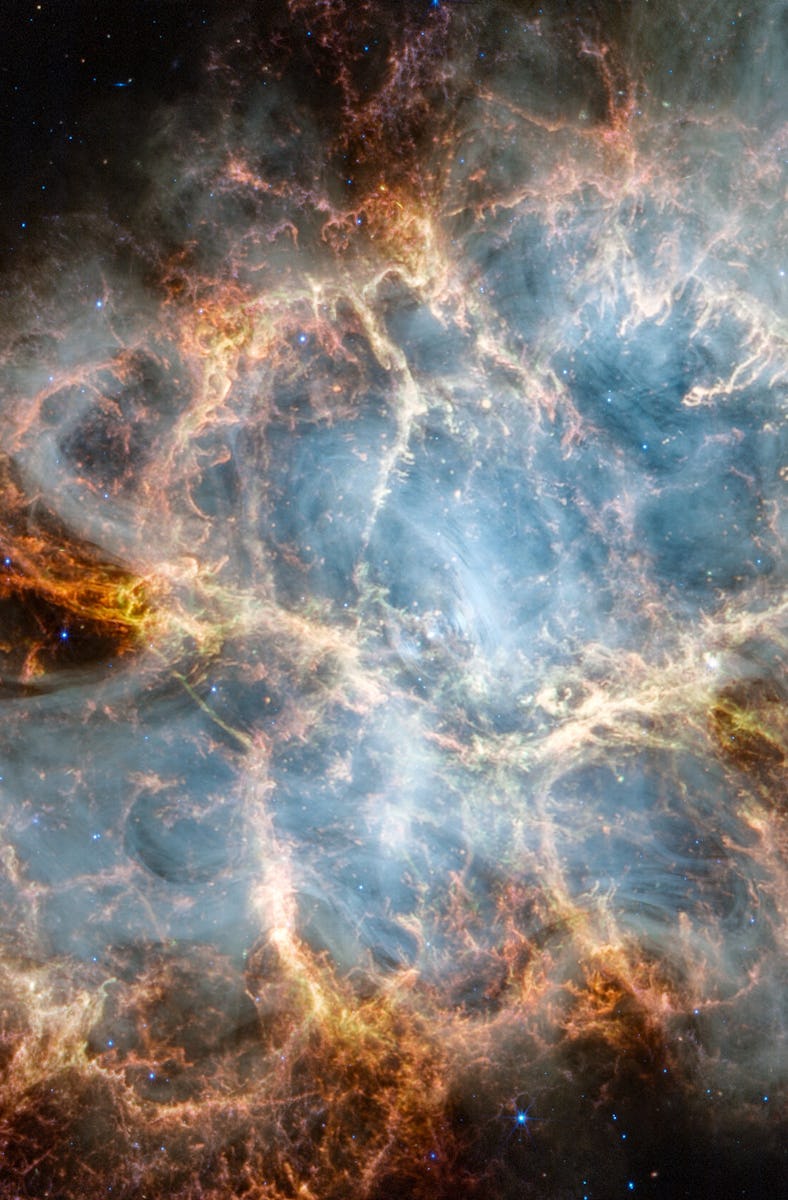Glimpse the Smoky Tendrils of the Crab Nebula's Pulsing Zombie Heart
On Monday, NASA published a stunning image of the Crab Nebula and the cosmic aftermath of a 1,000-year-old supernova.

When Chinese astronomers first glimpsed the Crab Nebula in 1054 CE — they didn’t see anything like this. A new photo courtesy of the James Webb Space Telescope (JWST) captures milky strands of material, known as synchrotron radiation, as it courses throughout the body of SN 1054 — a hat tip to the supernova remnant’s original discovery.
The $10 billion telescope, filled with an array of infrared instruments, began snapping photos of the universe in unprecedented detail in the summer of last year. In that short amount of time, JWST has already delivered groundbreaking revelations about our universe, and the Crab Nebula is its latest subject in a new image published on Monday by NASA.
The Magnetic Winds of a Neutron Star
The Crab Nebula is located in the constellation Taurus, and in 1054 CE, its star went supernova. Amazingly, the resulting explosion caught the attention of Chinese astronomers during the Song Dynasty, some 6,500 light years away. Fast forward 1,000 years later, and the nebula is an ever-expanding remnant of that medieval explosion, but interest in the nebula has only grown as we’ve improved ways to glimpse the cataclysmic aftermath.
But unlike previous images of this iconic cosmic object, the JWST reveals the smoke-like feature flushed throughout the nebula in greater detail. These ethereal wisps come from the pulse of the Crab Nebula’s zombie heart. When certain massive stars die, they go supernova by ejecting their outermost layer, leaving behind an ultra-dense object called a neutron star.
When some neutron stars rapidly rotate, they emit what NASA describes as a “milky smoke-like material,” known as synchrotron radiation. These wind-charged particles move around magnetic field lines, and as they blow through the supernova remnant, they push the Crab Nebula’s shell of gas and dust outward.
A Stellar death
The Princeton University research team behind the latest investigation relied on JWST’s Near-Infrared Camera (NIRCam) and Mid-Infrared Instrument (MIRI) to better understand the nebula’s origins and to explore how stars die. Stars are complicated objects, and what happens when one dies can be incredibly varied. That’s why detailed imagery like this one is necessary for scientists to unpack the complicated machinations of a star’s violent ending.
A neutron star, like the one in the center of the Crab Nebula, forms when a star roughly eight to 20 times the mass of the Sun runs out of hydrogen in its core. This triggers the beginning of the end. As NASA explains, a star will then begin to fuse helium into carbon, carbon into neon, neon into oxygen, oxygen into silicon, and silicon into iron.
“By the time silicon fuses into iron, the star runs out of fuel in a matter of days. The next step would be fusing iron into some heavier element, but doing so requires energy instead of releasing it,” NASA says.
The star’s core then collapses, and when it does, there emerges a cataclysmic shock wave that ripples through the star’s outer layers as the core rebounds to its original size, which creates a supernova.
“Webb’s sensitivity and spatial resolution allow us to accurately determine the composition of the ejected material, particularly the content of iron and nickel, which may reveal what type of explosion produced the Crab Nebula,” Princeton University’s Tea Temim shared in NASA’s announcement.
According to NASA, scientists will rely on new data from another major observatory, the Hubble Space Telescope, over the next year or so. By drawing comparisons, astronomers hope to get one step closer to providing brand-new insight into this 1,000-year-old cosmic explosion.
This article was originally published on